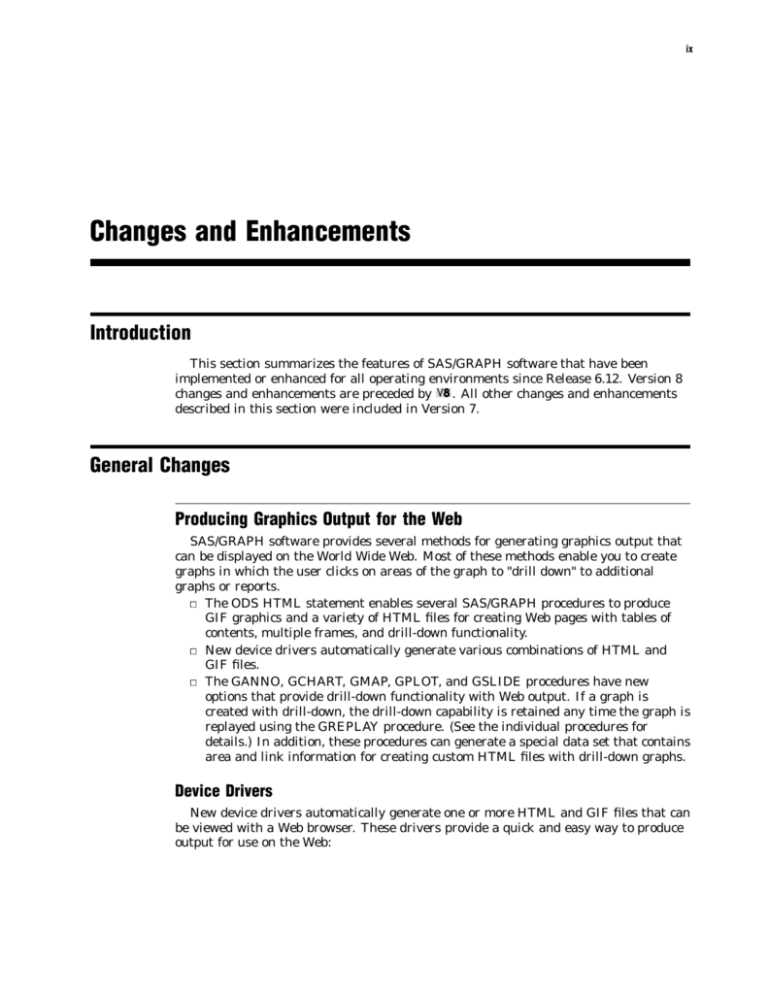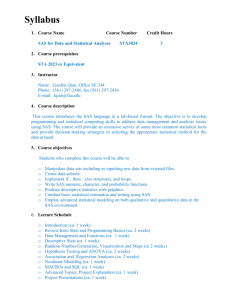
ix
Changes and Enhancements
Introduction
This section summarizes the features of SAS/GRAPH software that have been
implemented or enhanced for all operating environments since Release 6.12. Version 8
. All other changes and enhancements
changes and enhancements are preceded by
described in this section were included in Version 7.
General Changes
Producing Graphics Output for the Web
SAS/GRAPH software provides several methods for generating graphics output that
can be displayed on the World Wide Web. Most of these methods enable you to create
graphs in which the user clicks on areas of the graph to "drill down" to additional
graphs or reports.
3 The ODS HTML statement enables several SAS/GRAPH procedures to produce
GIF graphics and a variety of HTML files for creating Web pages with tables of
contents, multiple frames, and drill-down functionality.
3 New device drivers automatically generate various combinations of HTML and
GIF files.
3 The GANNO, GCHART, GMAP, GPLOT, and GSLIDE procedures have new
options that provide drill-down functionality with Web output. If a graph is
created with drill-down, the drill-down capability is retained any time the graph is
replayed using the GREPLAY procedure. (See the individual procedures for
details.) In addition, these procedures can generate a special data set that contains
area and link information for creating custom HTML files with drill-down graphs.
Device Drivers
New device drivers automatically generate one or more HTML and GIF files that can
be viewed with a Web browser. These drivers provide a quick and easy way to produce
output for use on the Web:
x
Changes and Enhancements
3 The GIF driver generates GIF graphics files from SAS/GRAPH procedures. These
files can be referenced in an HTML file and viewed with a Web browser.
3 The HTML driver creates a series of graphs in GIF format and an HTML file that
displays them.
3 The WEBFRAME driver also creates graphs in GIF format and HTML files, but it
produces a Web page whose table of contents contains thumbnail depictions of
each graph, plus links to the full-sized versions of the graphs.
3 The GIFANIM driver enables you to use SAS/GRAPH procedures to create GIF
animations for your Web pages.
New in Version 8, you can also use the ACTIVEX and JAVA device drivers. Both
drivers can only be used with procedures GCHART, GCONTOUR, GMAP, GPLOT, and
G3D, and both must be used with the Output Delivery System (ODS). The ACTIVEX
driver generates an HTML file that defines graphics output as ActiveX controls, and the
JAVA driver generates an HTML file that defines graphics output as a Java applet.
Both the ActiveX controls and the Java applets are interactive when displayed in a
browser. For example, they let you change the chart type from a bar chart to a pie chart.
Output Delivery System
SAS/GRAPH procedures that generate graphics output support the Output Delivery
System (ODS). You can use the ODS HTML statement or special SAS/GRAPH device
drivers to produce ODS output. When used with SAS/GRAPH procedures, either
method uses a default ODS template to produce HTML files and graphics output that
can be viewed with a Web browser.
Long Variable Names
SAS/GRAPH supports long variable names in data sets. Catalog entry names are
still limited to 8 characters. If longer names are specified, they are truncated.
SAS/GRAPH Fonts
SAS/GRAPH has added support for specifying long font names that appear in the
Charrec window of the GDEVICE procedure.
SAS/GRAPH Colors
SAS/GRAPH has added support for CMYK and HSB (or HSV) color types.
Features That Are No Longer Supported
A few SAS/GRAPH windows are no longer supplied:
3 PATTERN, AXIS, LEGEND, and SYMBOL windows
3 GRAPH manager window
A new file requestor window is provided for the Graphics Editor and the Graph
window.
Changes and Enhancements xi
SAS/GRAPH Procedures
GANNO Procedure
3 The NAME= option accepts a long variable name. However, when a variable name
is longer than 8 characters, the resulting entry name is truncated to 8 characters.
3 The IMAGEMAP= option creates a data set that contains information about a
graph and about areas in the graph. This information includes the shape and
coordinates of the areas, and it is used to build an HTML file that links the graph
areas to other files or images.
GCHART Procedure
The GCHART procedure includes the following new features:
3 The HBAR3D, VBAR3D, and PIE3D statements generate 3-dimensional horizontal
bar charts, vertical bar charts, and pie charts.
3 The WOUTLINE= option controls the thickness of the outlines of chart elements
(pie slices, bars, blocks, etc.).
3 The HTML= and HTML_LEGEND= options use HTML functionality to create
graphics output with "drill-down" capability.
3 The IMAGEMAP= option creates a data set that contains information about a
graph and about areas in the graph. This information includes the shape and
coordinates of the areas, and it is used to build an HTML file that links the graph
areas to other files or images.
New in Version 8, the DESCRIPTION= option can include the #BYLINE,
3
#BYVAL, and #BYVAR substitution options, which work as they do when used on
TITLE, FOOTNOTE, and NOTE statements.
Additional enhancements enable you to
3 format statistics and specify the label for statistic column heads in the table of
statistics that is displayed with horizontal bar charts
3 display statistic values inside bars in vertical bar charts
3 draw a frame around the axis area by default. The V6COMP graphics option
enables you to request Version 6 behavior instead of the new defaults.
Changes in the default behavior of the PATTERN statement may affect GCHART
procedure output.
GCONTOUR Procedure
Changes in the default behavior of the PATTERN statement may affect GCONTOUR
procedure output.
GDEVICE Procedure
You can specify a color map for a device using either
3 the new GDEVICE window, Colortable
3 the CMAP= option in the ADD or MODIFY statement in the GDEVICE procedure.
CMAP= can also be specified in the GOPTIONS statement.
xii Changes and Enhancements
GMAP Procedure
3 The map data sets that are supplied by SAS Institute have more consistent
structure and variables.
3 The HTML= and HTML_LEGEND= options use HTML functionality to create
graphics output with "drill-down" capability.
3 The IMAGEMAP= option creates a data set that contains information about a
graph and about areas in the graph. This information includes the shape and
coordinates of the areas, and it is used to build an HTML file that links the graph
areas to other files or images.
3 Changes in the default behavior of the PATTERN statement may affect GMAP
procedure output.
GOPTIONS Procedure
The OPTION= option requests information about the specified option only.
GPLOT Procedure
3 The FRAME | NOFRAME option draws a frame around the axis area by default.
The V6COMP graphics option enables you to request Version 6 behavior instead of
the new defaults. (V6COMP also affects the default behavior of the PATTERN
statement.)
3 The HTML= and HTML_LEGEND= options use HTML functionality to create
graphics output with "drill-down" capability.
3 The IMAGEMAP= option creates a data set that contains information about a
graph and about areas in the graph. This information includes the shape and
coordinates of the areas, and it is used to build an HTML file that links the graph
areas to other files or images.
3 Changes in the default behavior of the PATTERN statement may affect GPLOT
procedure output.
New in Version 8, the DESCRIPTION= option can include the #BYLINE,
3
#BYVAL, and #BYVAR substitution options, which work as they do when used on
TITLE, FOOTNOTE, and NOTE statements.
GSLIDE Procedure
The IMAGEMAP= option creates a data set that contains information about a graph
and about areas in the graph. This information includes the shape and coordinates of
the areas, and it is used to build an HTML file that links the graph areas to other files
or images.
Changes and Enhancements xiii
SAS/GRAPH Statements
Points as Units of Size
The height of text can be specified using points as the unit. These statements have
options that can use points as the unit:
3
3
3
3
AXIS
GOPTIONS
LEGEND
TITLE, FOOTNOTE and NOTE
AXIS Statement
3 The SPLIT= option defines a split character so that axis tables automatically
break to a new line when that character is encountered.
3 Date handling has been improved so that default intervals are more logical.
New in Version 8, the REFLINE= option specifies labels for one or more of the
3
reference lines that are displayed on an axis.
LEGEND Statement
The ORDER=() option orders, includes, or excludes legend entries.
PATTERN Statement
The default pattern for all types of graphs changed from hatch patterns to solid fills.
As a result, some default outlines and colors also changed. The V6COMP graphics
option enables you to request Version 6 behavior instead of the new defaults.
SYMBOL Statement
3 The BWIDTH= option controls the width of the box in box plots and the width of
the bar in HILOB plots. Both types of plots are produced with the GPLOT
procedure and are controlled by the INTERPOL= option of the SYMBOL
statement.
3
New in Version 8, the POINTLABEL= option specifies labels for one or more
plot points.
GOPTIONS Statement
3 These new options specify graphics commands:
3 PREGEPILOG
3 PREGPROLOG
3 POSTGEPILOG
xiv
Changes and Enhancements
3 POSTGPROLOG
3 These new options affect printing:
3 BINDING
3 COLLATE
3 DUPLEX
3 PAPERSOURCE
3 PAPERDEST
3 PAPERSIZE
3 PAPERTYPE
3 PPDFILE
3 REVERSE
3 These options affect device drivers or host commands used during graph
3
3
3
3
production:
3 CMAP
3 DRVINIT
3 DRVTERM
3 FILECLOSE
3 PREGRAPH
3 POSTGRAPH
3 UCC
These new options affect GIF animation:
3 DELAY
3 DISPOSAL
3 ITERATION
3 INTERLACED
3 TRANSPARENCY
These enhanced options control the size of images used for Web output:
3 AUTOSIZE
3 XMAX
3 XPIXELS
3 YMAX
3 YPIXELS
The FILEONLY option specifies whether a file or a storage location is the default
destination for graphics output.
The V6COMP option enables programs that were developed in Version 6 to run
but maintain certain Version 6 behaviors. V6COMP affects the default behavior of
the PATTERN statement and of axis area frames.
The Annotate Facility
3 The CBOX and CBORDER variables blank out a box behind text that is specified
with the LABEL function. They also color the box and the border of the box.
3 The HTML variable defines a link in the HTML file created for a drill-down graph.
This link is associated with an area of the graph and contains valid HTML syntax
that can point to a report or another graph that you want to display when the user
drills down on the area.
The correct bibliographic citation for this manual is as follows: SAS Institute Inc.,
SAS/GRAPH ® Software: Reference, Version 8, Cary, NC: SAS Institute Inc., 1999.
1240 pp.
SAS/GRAPH® Software: Reference, Version 8
Copyright © 1999 by SAS Institute Inc., Cary, NC, USA.
ISBN 1–58025–525–6
All rights reserved. Printed in the United States of America.
U.S. Government Restricted Rights Notice. Use, duplication, or disclosure of the
software by the government is subject to restrictions as set forth in FAR 52.227–19
Commercial Computer Software-Restricted Rights (June 1987).
SAS Institute Inc., SAS Campus Drive, Cary, North Carolina 27513.
1st printing, October 1999
SAS® and all other SAS Institute Inc. product or service names are registered trademarks
or trademarks of SAS Institute Inc. in the USA and other countries. ® indicates USA
registration.
OS/2® , OS/390® , and IBM® are registered trademarks or trademarks of International
Business Machines Corporation.
Other brand and product names are registered trademarks or trademarks of their
respective companies.
The Institute is a private company devoted to the support and further development of its
software and related services.









